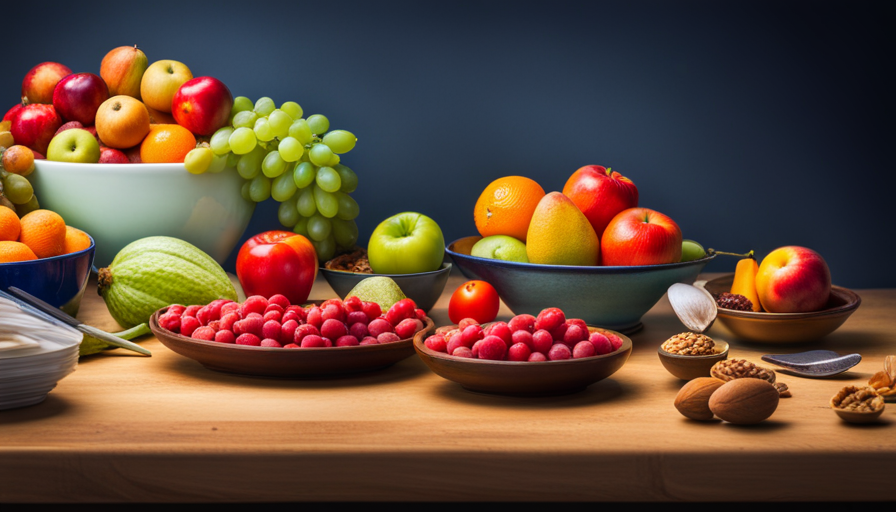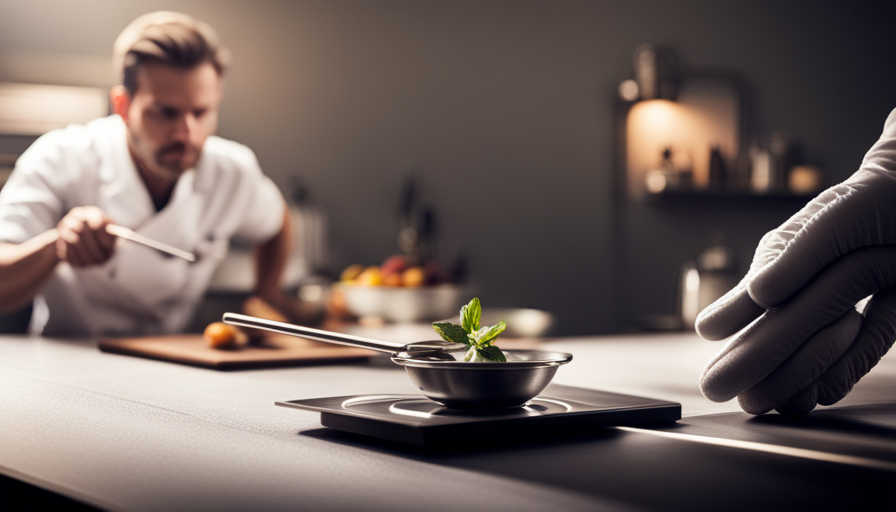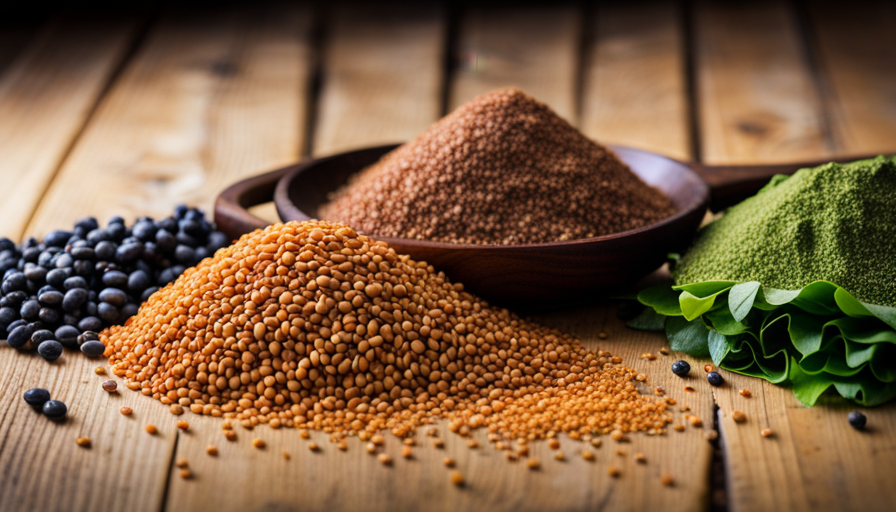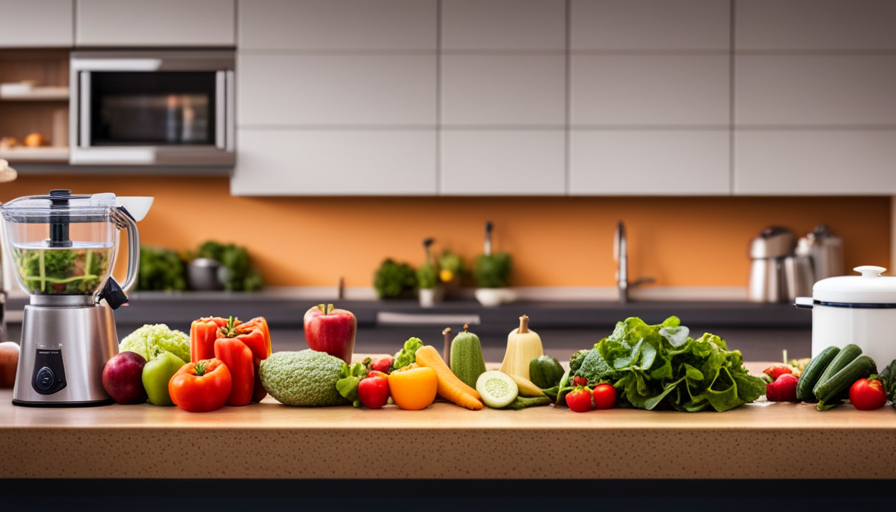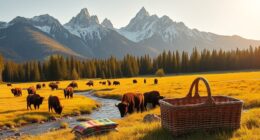Did you know that incorporating beans into your raw diet can provide you with a great source of protein, fiber, and essential nutrients?
In fact, studies have shown that beans can help improve heart health, regulate blood sugar levels, and support weight management.
With their versatility and countless health benefits, beans are a must-have ingredient for anyone following a raw food diet.
In this article, we will explore various ways to incorporate beans into your meals, from soaking and sprouting them for maximum nutrition, to blending them into smoothies and dressings.
We will also discuss how to create bean-based dips, spreads, burgers, and patties, as well as adding them to salads, grain bowls, and even raw desserts.
By the end of this article, you will have a variety of delicious and nutritious ways to enjoy beans in your raw food diet.
So, let’s dive in and discover the incredible possibilities of incorporating beans into your daily meals!
Key Takeaways
- Soaking and sprouting beans in a raw food diet maximizes their nutritional benefits.
- Bean-based smoothies, dressings, dips, and spreads are delicious and healthy alternatives.
- Incorporating beans into salads, grain bowls, soups, and stews adds filling and nutritious elements.
- Experimenting with different flavors and textures of beans can inspire new raw food recipes that are both delicious and nourishing.
Soaking and Sprouting Beans for Maximum Nutrition
To maximize the nutritional benefits, it’s essential to soak and sprout beans in a raw food diet. Sprouting benefits the beans by increasing their nutrient content and making them easier to digest.
During the sprouting process, the beans release enzymes that break down complex carbohydrates, proteins, and fats. This makes them more bioavailable, meaning your body can absorb and utilize the nutrients more efficiently.
To start the sprouting process, first, rinse the beans thoroughly and remove any debris. Then, place them in a jar and cover them with water. Soaking techniques vary depending on the type of bean, but a general guideline is to soak them for around 8-12 hours.
After soaking, drain the water and rinse the beans again. Place a mesh or cheesecloth over the jar and secure it with a rubber band. Invert the jar at a slant to allow excess water to drain. Rinse and drain the beans twice a day until you see small sprouts emerging.
By soaking and sprouting beans, you can enhance their nutritional profile and make them more digestible. So don’t skip this important step in your raw food diet. Incorporating sprouted beans into your meals will not only add variety but also provide you with a wholesome and nutrient-dense source of plant-based protein.
Blending Beans into Smoothies and Dressings
Start by throwing some legumes into your blender and watch as they seamlessly blend into your smoothies and dressings, adding a burst of flavor and a creamy texture.
Beans are a versatile ingredient that can be incorporated into your raw food diet in various ways. One way to enjoy the benefits of beans is by creating bean-based smoothies. These smoothies not only provide a great source of protein and fiber, but they also add a unique twist to your usual smoothie routine.
Try blending black beans with bananas, cocoa powder, and almond milk for a delicious and nutritious chocolate smoothie. Or, combine white beans with spinach, pineapple, and coconut water for a refreshing green smoothie.
In addition to smoothies, you can also use blended beans to create flavorful dressings. By blending beans with herbs, spices, and a splash of vinegar, you can create a creamy and tangy dressing that pairs well with salads or raw vegetable platters.
For a simple and delicious dressing, blend chickpeas with garlic, lemon juice, olive oil, and tahini. This creamy dressing adds a burst of flavor to any salad and provides a boost of protein.
Incorporating beans into your raw food diet through smoothies and dressings is a great way to enhance both the taste and nutritional value of your meals. So go ahead, get creative with bean-based smoothie recipes and dressings using blended beans. Your taste buds and body will thank you.
Creating Bean-Based Dips and Spreads
Get ready to elevate your snacking game with delicious and creamy dips and spreads made from blended legumes. Bean-based dips are not only a healthy snack alternative, but they also add a burst of flavor to your raw food diet. You may be wondering how to incorporate beans into your dips and spreads, so let’s explore some creative ways to use beans in spreads and condiments.
One popular option is to make a classic hummus using chickpeas. Simply blend cooked chickpeas with tahini, lemon juice, garlic, and olive oil until smooth. This creamy dip is perfect for dipping raw veggies or spreading on raw crackers.
Another option is to experiment with different types of beans, like black beans or white beans, to create unique and flavorful spreads. Blend cooked beans with spices, herbs, and a touch of olive oil for a delicious and nutritious spread.
To help you get started on your bean-based dip and spread journey, here’s a table with some inspiration:
| Bean-based Dip/Spread | Ingredients |
|---|---|
| Classic Hummus | Chickpeas, tahini, lemon juice, garlic, olive oil |
| Black Bean Spread | Black beans, cumin, coriander, lime juice, olive oil |
| White Bean and Rosemary Spread | White beans, rosemary, garlic, lemon juice, olive oil |
Incorporating beans into your raw food diet doesn’t have to be boring. With these creative and tasty dips and spreads, you can enjoy the health benefits of legumes while satisfying your snacking cravings.
Making Bean Burgers and Patties
Let’s dive into the world of mouthwatering bean burgers and patties, a delicious and satisfying way to enjoy the versatility of legumes in your meals. Beans aren’t just packed with nutrients but also lend a great texture and flavor to these plant-based alternatives.
To begin, consider making a bean-based pizza crust. This innovative twist on a classic favorite isn’t only gluten-free but also adds a boost of fiber and protein to your pizza. Simply blend cooked beans with some spices, herbs, and a binding agent like flaxseed or chia seeds. Spread the mixture onto a baking sheet and bake until crispy. Top it with your favorite pizza toppings and enjoy a guilt-free indulgence.
Another fantastic option is bean-filled lettuce wraps. Use cooked beans as a filling for lettuce leaves, along with a variety of fresh vegetables and toppings. This light and refreshing dish isn’t just quick to prepare but also a great option for those looking for a low-carb or gluten-free alternative to traditional burgers.
Incorporating beans into your diet through these creative options not only adds a burst of flavor but also provides essential nutrients. So, go ahead and explore the world of bean burgers and patties for a satisfying and healthy meal.
Adding Beans to Salads and Grain Bowls
Enhance your salads and grain bowls with the irresistible texture and flavor of nutrient-rich beans, taking your meals to a whole new level of deliciousness. Beans are not only a great source of protein, but they also provide a good amount of fiber, vitamins, and minerals. They can easily be added to salads and grain bowls to make them more filling and nutritious.
One way to add beans to your salads and grain bowls is by roasting them. Roasting beans not only adds a crispy texture, but it also enhances their flavor. Simply toss your favorite beans with a little olive oil, salt, and any other desired seasonings, then spread them out on a baking sheet and roast in the oven until crispy. These roasted beans can be sprinkled on top of your salads or grain bowls for an extra crunch.
Another creative way to incorporate beans into your salads and grain bowls is by using them in homemade energy bars. Beans can be pureed and mixed with other ingredients like oats, dates, and nuts to create a nutritious and energizing snack. Not only do they add a creamy texture to the bars, but they also provide a good amount of protein and fiber to keep you satisfied and full of energy throughout the day.
Incorporating beans into your salads and grain bowls is a simple and delicious way to boost the nutritional value of your meals. Whether you’re roasting them for added texture and flavor or using them in homemade energy bars, beans are a versatile ingredient that can take your dishes to the next level.
Using Beans in Raw Soups and Stews
Now that you’ve learned about adding beans to salads and grain bowls, let’s dive into another exciting way to incorporate beans into your raw food diet – using them in raw soups and stews.
Raw soups and stews are a fantastic way to enjoy the goodness of beans while still keeping them in their raw state. By using a high-speed blender or a food processor, you can create delicious and nutritious soups that are packed with flavor.
One interesting technique to maximize the benefits of beans in raw soups is by fermenting them. Fermentation not only enhances the taste but also increases the nutritional value of the beans. The process of fermentation breaks down complex carbohydrates and proteins, making them easier to digest and allowing for better absorption of nutrients by your body.
In addition to soups, you can also experiment with using beans in raw desserts. Pureed beans can be used as a base for creamy fillings in cakes, pies, and even ice creams. They add a richness of texture and taste, while also providing a good source of protein and fiber.
So, whether you’re enjoying a warm and comforting raw soup or indulging in a guilt-free raw dessert, incorporating beans into your raw food diet is a delicious and nutritious way to boost your overall health and well-being.
Fermenting Beans for Probiotic Benefits
Boost your gut health and enjoy the probiotic benefits of fermented beans in your soups and stews. Fermenting beans is a great way to make them easier to digest and increase their nutritional value.
When beans are fermented, they undergo a process called lacto-fermentation, where beneficial bacteria break down the sugars and starches in the beans, creating lactic acid. This lactic acid not only gives the beans a tangy flavor but also promotes the growth of healthy gut bacteria.
To ferment beans, start by soaking them overnight in water. Then, rinse and drain the beans before placing them in a jar or a fermentation crock. Add water and a small amount of salt to create a brine solution. The salt helps create an environment that is favorable for the growth of beneficial bacteria while inhibiting the growth of harmful bacteria. You can also add spices and herbs like garlic, ginger, or dill to enhance the flavor.
After the beans are submerged in the brine, cover the jar with a tight-fitting lid or a fermentation weight to keep the beans submerged. Allow the beans to ferment at room temperature for about 3-5 days, depending on your preference. During this time, the bacteria will convert the sugars in the beans into lactic acid, creating a tangy and probiotic-rich food.
Once the beans have reached your desired level of fermentation, transfer them to the refrigerator to slow down the fermentation process. Fermented beans can be added to your raw soups and stews, providing a boost of probiotics and improving your gut health.
So, give fermented beans a try and enjoy the benefits they offer for your digestive system.
Dehydrating Beans for Snacks and Crackers
Satisfy your cravings and embark on a crunchy journey by transforming beans into delectable snacks and crispy crackers. Dehydrating beans is a great way to preserve them for long-term storage while also unleashing their full flavor potential.
Not only does dehydration extend the shelf life of beans, but it also concentrates their taste, making them even more delicious.
To begin the process, start by soaking your favorite beans overnight to soften them. Once they’ve soaked, rinse them thoroughly and spread them out on a dehydrator tray in a single layer. Set the dehydrator to a low temperature, around 125°F (52°C), and let the beans dry for about 8 to 12 hours. You’ll know they’re ready when they’re dry and crispy.
Now that you have a batch of dehydrated beans, the possibilities are endless. You can use them as a crunchy topping for salads or soups, or you can grind them into a powder to add a nutritious boost to smoothies or baked goods. They can even be rehydrated and incorporated into recipes like stews or dips.
So, get creative and explore the diverse ways to use dehydrated beans in your meals. Not only will you be adding a satisfying crunch to your dishes, but you’ll also be incorporating a nutritious ingredient that can be enjoyed for months to come.
Incorporating Beans into Raw Desserts and Treats
Indulge your sweet tooth and discover a whole new world of dessert possibilities by infusing your treats with the goodness of beans. Beans may not be the first ingredient that comes to mind when you think of desserts, but they can add a nutritious twist to your raw food creations.
Here are some ideas to incorporate beans into your raw desserts and treats:
-
Raw Bean Brownies: Replace traditional flour with mashed black beans for a fudgy and protein-packed brownie base. Add raw cacao powder, dates, and a touch of coconut oil for a rich and decadent treat.
-
Bean-Based Ice Cream: Blend soaked cashews, coconut milk, and cooked white beans for a creamy ice cream base. Add your favorite flavors like vanilla extract, berries, or raw cacao nibs. Freeze it and enjoy a guilt-free frozen delight.
-
Bean Protein Balls: Mix mashed chickpeas, almond butter, dates, and your choice of nuts or seeds. Roll them into bite-sized balls and refrigerate for a quick and satisfying snack.
-
Bean Mousse: Blend cooked kidney beans with avocado, raw cacao powder, and a natural sweetener like maple syrup or dates. The result is a silky and chocolatey mousse that will satisfy your dessert cravings.
Incorporating beans into your raw desserts not only adds a nutritional boost but also enhances the texture and flavor of your treats. So, go ahead and experiment with these bean-infused recipes and enjoy guilt-free indulgence.
Exploring Different Bean Varieties and Flavors
Now that you have learned how to incorporate beans into raw desserts and treats, let’s dive deeper into the world of bean varieties and flavors. Exploring different types of beans not only adds versatility to your raw food diet but also provides a multitude of health benefits.
Incorporating various bean varieties into your meals can inspire a whole range of delicious and nutritious raw food recipes. From chickpeas to black beans to kidney beans, each type offers its own unique flavor and texture. You can use them in salads, dips, spreads, and even raw soups.
To help you understand the differences between bean varieties, here is a table outlining some popular types along with their health benefits:
| Bean Variety | Flavor | Health Benefits |
|---|---|---|
| Chickpeas | Nutty | High in protein, fiber, and iron. Good for heart health and digestion. |
| Black beans | Earthy | Rich in antioxidants, fiber, and folate. Can help regulate blood sugar levels. |
| Kidney beans | Creamy | Excellent source of plant-based protein, fiber, and antioxidants. Beneficial for bone health and weight management. |
By incorporating a variety of beans into your raw food diet, you not only add depth to your meals but also reap the nutritional rewards that these legumes offer. Experiment with different flavors and textures to create bean-inspired raw food recipes that are both delicious and nourishing.
Frequently Asked Questions
Can I eat beans raw without soaking or sprouting them?
No, it’s not recommended to eat beans raw without soaking or sprouting them. Soaking or sprouting beans helps to remove anti-nutrients and improve their digestibility. Soaking for 8-12 hours and sprouting for 2-4 days can enhance the nutritional profile of beans by increasing their vitamin and mineral content. Sprouting also activates enzymes that aid in digestion. Therefore, soaking or sprouting beans before eating them is beneficial for your health.
Can I substitute beans with other ingredients in bean-based dips and spreads?
Yes, you can definitely substitute beans with other ingredients in bean-based dips and spreads. While beans are a great source of protein and fiber, there are other ingredients that can provide similar benefits.
For protein, you can use ingredients like nuts, seeds, or even tofu. And for fiber, you can include vegetables like carrots or zucchini. Just be sure to properly prepare and store these ingredients to ensure they’re safe for raw consumption.
How do I make bean burgers and patties without cooking them?
Who needs burgers that are actually cooked when you can have raw bean burgers? Raw food bean recipes are all the rage in the world of health-conscious individuals. Not only are bean burgers and patties a delicious alternative to their cooked counterparts, but they also offer a wide range of benefits when incorporated into a raw diet.
Beans are packed with protein, fiber, and essential nutrients, making them a perfect addition to any raw food enthusiast’s repertoire.
Can I add canned beans to salads and grain bowls instead of fresh ones?
Yes, you can definitely add canned beans to salads and grain bowls instead of fresh ones. There are several benefits to using canned beans in raw food recipes. Firstly, they’re convenient and don’t require any cooking or soaking. Secondly, they have a longer shelf life, making them more accessible. To properly incorporate canned beans, make sure to rinse them thoroughly to remove excess sodium and preservatives. Additionally, you can mix them with fresh vegetables and dressings to enhance the flavors in your salads and grain bowls.
What are some alternative ways to incorporate beans in raw desserts and treats?
Looking for a unique way to satisfy your sweet tooth while incorporating beans into your raw food diet? Look no further! How about trying bean-based smoothies? They’re not only delicious but also packed with protein and fiber.
Another tasty option is to make unique bean-filled raw energy bars. These treats will give you the energy boost you need while keeping you on track with your raw food lifestyle.
So go ahead, get creative and enjoy the benefits of beans in your desserts!
Can Lentils Be Included in a Raw Food Diet that Incorporates Beans?
Yes, lentils can be included in a raw food diet that incorporates beans. When preparing lentils raw food, it’s important to soak them for at least 8 hours to make them more digestible. Sprouting lentils can also enhance their nutritional value and make them suitable for a raw food diet.
Conclusion
In conclusion, you now have a variety of creative ways to incorporate beans into your raw food diet. Whether it’s soaking and sprouting for maximum nutrition or blending into smoothies and dressings, beans can add a nutritious punch to your meals.
Don’t forget about making bean burgers and patties, adding them to salads and grain bowls, or even fermenting them for probiotic benefits. And for those looking for a crunchy snack, dehydrating beans for snacks and crackers is a great option.
Lastly, don’t be afraid to explore different bean varieties and flavors to keep things interesting and enjoyable. So go ahead, get creative, and reap the many benefits of beans in your raw food diet!


